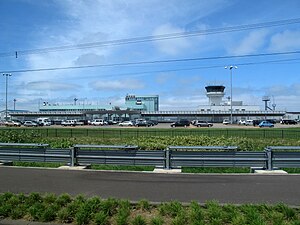Wakkanai Airport
|
Wakkanai Airport 稚内空港 Wakkanai Kūkō |
|||||||||||
|---|---|---|---|---|---|---|---|---|---|---|---|
 |
|||||||||||
| Summary | |||||||||||
| Airport type | Public | ||||||||||
| Operator | Ministry of Land, Infrastructure, Transport and Tourism | ||||||||||
| Location | Wakkanai | ||||||||||
| Elevation AMSL | 27 ft / 8 m | ||||||||||
| Coordinates | 45°24′16″N 141°48′08″E / 45.40444°N 141.80222°ECoordinates: 45°24′16″N 141°48′08″E / 45.40444°N 141.80222°E | ||||||||||
| Website | http://www.wkj-airport.jp/ | ||||||||||
| Map | |||||||||||
| Location in Japan | |||||||||||
| Runways | |||||||||||
|
|||||||||||
| Statistics (2015) | |||||||||||
|
|||||||||||
|
Source: Japanese Ministry of Land, Infrastructure, Transport and Tourism
|
|||||||||||
| Passengers | 184,779 |
|---|---|
| Cargo (metric tonnes) | 231 |
| Aircraft movement | 2,732 |
Wakkanai Airport (稚内空港 Wakkanai Kūkō?) (IATA: WKJ, ICAO: RJCW) is an airport located 10 km (6.2 mi) east southeast of Wakkanai, Hokkaidō, Japan.
Wakkanai is the northernmost airport in Japan which is capable of handling jet aircraft; due to its small size, it is susceptible to closures during the coldest winter months, in which case incoming aircraft are often diverted to Asahikawa Airport. It has one jet bridge, one apron gate for mid-sized jet aircraft, and two apron gates for commuter aircraft.
Wakkanai Airport opened to passenger traffic in 1960, initially on an irregular basis. Air Nippon began scheduled service to Okadama Airport and Rishiri Airport in 1974, followed by Rebun Airport in 1978 and New Chitose Airport in 1980. Air Nippon discontinued the short Rebun and Rishiri commuter flights in 2003 due to poor load factors.
In 1987, the 1,200 m main runway was extended to 1,800 m, allowing All Nippon Airways to begin jet service to Tokyo. The flight was initially seasonal and did not become a year-round service until 1997. The city of Wakkanai provided subsidies for city residents to use the flight until 2005, when discounted fares became available.
As of 2015, ANA has two scheduled daily round trips to Sapporo using Bombardier Q400 turboprops, and one scheduled daily round trip to Tokyo (two from June to September) using Boeing 737 jets.
...
Wikipedia


